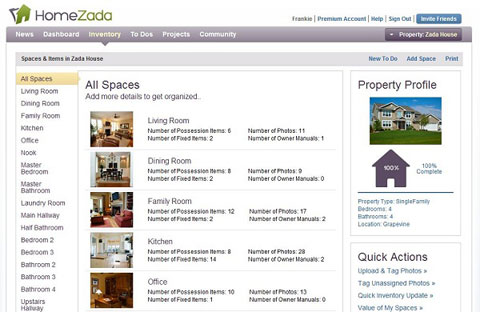Helping Your Clients Keep Track of All Their Belongings With Home Inventory Apps
This page may contain links to Amazon.com or other sites from which I may receive commission on purchases you make after clicking on such links. Read my full Disclosure Policy

The thought of offering home inventory as a service has always intrigued me and seemed like a good fit with home organizing. If you’ve thought about it too, you’ll be happy to know there are now all kinds of home inventory apps to make the job even easier. This article by Sarah Hollenbeck explains what to look for and compares nine of the most popular home inventory apps.

Organization is a skill that takes a keen eye and tons of dedication. Whether you’re tackling a single closet or an entire estate, having an account of all the items will make the job easier, faster and more accurate. Using a home inventory app is a great way to help clients catalogue the items in their home, keep them organized and have records in case items are lost or stolen. Part of being a professional organizer is helping clients not only organize all their things, but protect them as well.
Taking a home inventory is a great way to fully organize a home, especially before a move. A home inventory basically serves two purposes. It allows you to value all the items in home for insurance purposes and from an organization standpoint it tells you what you can put where, what can be stored, what is going to be used and what is donation material.
What Goes Into A Home Inventory?
Even for a professional organizer the idea of taking a complete home inventory can seem like a daunting task. There’s a lot of information that goes into a proper home inventory, but the benefits are well worth it. While you can just take pictures or video of all the items in a home, going the more detailed route will save time and effort in the long run.
Here’s the types of information you’ll need:
- Item Descriptions: A good way to do this is to pull the item description from the actual manufacturer so that features and uses are accurate.
- A Video or Photograph: This helps to show the condition of the item. This is highly important in the event of an insurance claim.
- Cost at Time of Purchase: This helps to determine the accurate value of an item. Receipts or barcodes on packaging are great time savers.
- Appraisal Value: This is important for high value, rare, or precious items. Determining replacement value of such items after the fact can be difficult, so having an appraisal done helps save time and effort.
- Date and Location of Purchase: This is another step where receipts are worth their weight in gold and can aid in replacing those items if needed.
- Serial Numbers: This is one that often gets overlooked, serial numbers are important for proof of ownership and for identifying the specific make and model of an item.
What Is A Home Inventory App?
Even when working from home, helping clients stay organized is an important job. There have been a lot of technological innovations in recent years that work with home organization and even insurance policies to help keep track of belongings. This is also true for taking a home inventory. A home inventory app is an application for your tablet or smartphone that helps you keep track of an item, its location and its value. The app becomes like your own personal notebook you can fill with all the details of the item that you need. This not only helps you keep your clients’ lives organized easier, it helps clients in the event they misplace an item or need to file with their insurance company.
For organizers, better client records means happier clients and a home inventory app makes keeping records a breeze. You can use a home inventory app to create descriptions, add notes and addendums, organize items by location, value or type, and since it’s constantly portable, you never have to fear losing track of what you’ve done.
So, Why Do A Home Inventory?
Beyond the basic point of being organized, especially before or after a big move, you want to know what you have, where it is and what it’s worth. A home inventory means taking stock of literally everything you own. This is typically done for the purposes of home insurance so that, in the event you need to make a claim, you have all the documentation you will ever need to file it properly.
You may think you know what you have, but when it comes to losing important or irreplaceable items, it’s better to be safe than sorry. Taking a home inventory is a way to make certain that everything is accounted for and using a home inventory app is a great way to keep everything together.
What To Look For In A Home Inventory App
When deciding what home inventory app to use, there are a few things to look out for to make the process much easier.
- Label Making Function: The ability to make and print labels for items helps keep them organized and easier to find and identify.
- Photo or Video Upload Function: Having the ability to upload photos or videos of all the items in a home inventory is great for documentation purposes. You can record the exact make and model of an item as well the shape it was in at the time of organization
- Barcode Scanner: This allows you to scan items to find complete item descriptions. This is a great time saving feature for cataloging items for insurance purposes
- Category Options: Organizing items by location, use, item type, or room streamlines the entire packing and unpacking progress and helps keep items where they belong.
- Cloud Storage: Being able to access your inventory list from anywhere simplifies paperwork for clients, and allows you to always be able to adjust with the situation and work from anywhere as well.
- Calculation Function: Having a calculator available in your home inventory app allows you tabulate item values and accurately estimate the worth of all the items in a home inventory. This helps clients decide how much home insurance coverage they need for their possessions.
- Search Function: This allows you to quickly look up items in an inventory list and make sure everything has been counted or to find items in the event of a claim.
Home inventory apps not only streamline the process of creating a home inventory, they allow you to always keep records and pertinent information on hand for clients in the event that someone needs to file an insurance claim for lost or damaged items. Check out this list of the best home inventory apps for home organizers from Hippo in the infographic below.





These are a neat idea. Kind of time consuming, but certainly feels worth it if a natural disaster strikes! I believe HomeZada also offers this, and is a NAPO Business partner. The barcode scanner is a feature I wouldn’t have though to look for, but I can certainly see how this could save a lot of time! Nice to “meet” you here on Janet’s blog.
Yes, HomeZada has been featured here before (see Related Posts below).
My husband did a home inventory many years ago using a spreadsheet. It was really eye-opening to see the total value of our household goods!
Sortly recently changed its focus and it’s now on managing business inventories, rather than creating home inventories, with prices starting at $39/month. They still have a free version, but it’s with a limit of 100 items. https://www.sortly.com/pricing/.
Thanks for the heads up! 100 items sounds like a lot, but it’s really not.
It’s funny, but just reading about doing a home inventory and all the great ways to organize the material makes me want to do it. Yes. It would be time-consuming. But I can imagine doing one room, category, or area at a time. I remember decades ago when my parents did a partial home inventory. It wasn’t very elaborate, and it was before technology apps were available. They took pictures of all the rooms, furniture, and art, and items inside cabinets. And while they didn’t assign dollar values to anything, they had a visual record in case of a catastrophe.
That’s very interesting. I suspect the main reason of assigning dollar values is to make sure you have adequate insurance to replace everything in the event of a fire or other disaster. My husband did an inventory a very long time ago and entered the estimated replacement cost of everything – it was a real eye-opener.
This is one of those things that seems like such a good idea but we put off because it feels like it would take so long – technology is definitely nudging me towards this now. Great round up of what’s out there to help with this task.
The thought of it is pretty overwhelming, but Linda’s suggestion to work on one room or area at a time might help – as long as you didn’t move things around before you were done!
I did this some years ago but need to revisit it again since it has been over ten years. Thanks for sharing these apps.
Ten years is a long time! I’m not sure how much time passed between my husband creating our inventory and when we pulled it out again, but I bet half the stuff on it had been replaced in the meantime.
I imagine that doing a home inventory would lead to a lot of purging; when you get to an item and feel like, “Nah, I don’t even want to enter this into the database,” it’s a good clue you wouldn’t replace it if it got damaged or stolen.
I wonder how deeply one usually goes with a home inventory. For me, once you eliminate the books, CDs, and clothing (which I don’t imagine people itemize?), there’s almost nothing worth tracking: a computer, a few electronic devices. I live like a college student! But for clients, I think these are all intriguing. I’d be most inclined to use Home Zada for a full-on home inventory, but it’s exciting to see all of these options.
I suppose it depends on the purpose of the inventory. If it’s for insurance, you probably wouldn’t need to itemize smaller objects, but you might list “clothing – replacement value $$$” for example.
Maybe this could be a new niche for my business in the future. Food for thought. Thanks for feeding me.
So many opportunities, so little time… right, Julie?
Thanks for all the information. Sortly is the only inventory app I’ve used on this list, so I’ll look into the others.